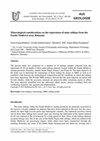The Tendency Towards Secondarity in Managing Global Imbalances
Q4 Mathematics
Analele Stiintifice Ale Universitatii Al I Cuza Din Iasi - Matematica
Pub Date : 2015-11-01
DOI:10.1515/aicue-2015-0020
引用次数: 2
Abstract
Abstract In this study, we analyse the factors that have led to the fall of real interest rates on the long term. We show that this tendency, i.e. the fall in real interest rates, which began three decades ago in developed countries is well explained by the emergence and growth of the global saving glut. We formulate the hypothesis according to which the increase in the global excess saving is mostly the result of a process whereby countries place themselves on a secondary position vis-à-vis the US (i.e. secondarity) with regard to taking and managing risks which occur after a crisis. The ensuing peculiarity of global excess saving is that it is generated in an increasing number of countries or economic areas, with the overwhelming part located in a few of them, while the overwhelming part of the global deficit of savings is located in the US. Secondarity is caused both by governments, which have sought to move to excess saving, as was the case of Asian countries (Bernanke, 2005), or to capping budget deficits, as it happened in the Eurozone and in the EU, and by the free choice of every economic agent in the private sector. Secondarity represents a major cause for a vicious circle in which the decline in interest rates to ever lower levels has led to the emergence of financial bubbles, whose bursting requires the further reduction of interest rates, thus generating new bubbles and so on and so forth. Misinterpreted in real time as the “Great Moderation”, this vicious circle went unobserved.管理全球失衡的次要倾向
在本研究中,我们分析了导致长期实际利率下降的因素。我们表明,这种趋势,即实际利率的下降,始于30年前的发达国家,可以很好地解释为全球储蓄过剩的出现和增长。我们提出了一个假设,根据这个假设,全球储蓄过剩的增加主要是一个过程的结果,在这个过程中,在承担和管理危机后发生的风险方面,各国将自己置于与-à-vis美国相比的次要地位(即次要地位)。随之而来的全球储蓄过剩的特点是,它产生于越来越多的国家或经济区域,绝大部分位于其中的少数几个国家,而全球储蓄赤字的绝大部分位于美国。其次是由于政府试图转向过度储蓄,如亚洲国家(伯南克,2005),或限制预算赤字,如在欧元区和欧盟发生的情况,以及私营部门中每个经济主体的自由选择。次级市场是恶性循环的主要原因,在这种恶性循环中,利率下降到越来越低的水平导致金融泡沫的出现,而金融泡沫的破裂需要进一步降低利率,从而产生新的泡沫,如此循环往复。这种恶性循环在当时被误读为“大缓和”(Great Moderation),没有人注意到。
本文章由计算机程序翻译,如有差异,请以英文原文为准。
求助全文
约1分钟内获得全文
求助全文
来源期刊
CiteScore
0.70
自引率
0.00%
发文量
2
审稿时长
>12 weeks
期刊介绍:
This journal is devoted to the publication of original papers of moderate length addressed to a broad mathematical audience. It publishes results of original research and research-expository papers in all fields of mathematics.

 求助内容:
求助内容: 应助结果提醒方式:
应助结果提醒方式:


